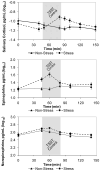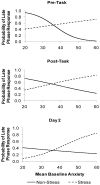How stress and anxiety can alter immediate and late phase skin test responses in allergic rhinitis
- PMID: 19150180
- PMCID: PMC2819057
- DOI: 10.1016/j.psyneuen.2008.11.010
How stress and anxiety can alter immediate and late phase skin test responses in allergic rhinitis
Abstract
Allergic rhinitis (AR) is the fifth most common chronic disease, and the association between allergic disorders and anxiety is well-documented. To investigate how anxiety and stressors modulate skin prick test (SPT) responses and associated inflammatory responses, 28 men and women with AR were selected by clinical history and skin test responses. The participants were admitted twice to a hospital research unit for 4h in a crossover trial. Changes in SPT wheals were assessed before and after a standardized laboratory speech stressor, as well as again the following morning; skin responses assessed twice during a lab session without a stressor and again the following morning served as the contrast condition. Anxiety heightened the magnitude of allergen-induced wheals following the stressor. As anxiety increased, SPT wheal diameters increased after the stressor, compared to a slight decrease following the control task. Anxiety also substantially enhanced the effects of stress on late phase responses: even skin tests performed the day after the stressor reflected the continuing impact of the speech stressor among the more anxious participants. Greater anxiety was associated with more IL-6 production by Con A-stimulated leukocytes following the stressor compared to the control visit. The data suggest that stress and anxiety can enhance and prolong AR symptoms.
Figures






Similar articles
-
Stress and anxiety effects on positive skin test responses in young adults with allergic rhinitis.Ann Allergy Asthma Immunol. 2014 Jul;113(1):13-8. doi: 10.1016/j.anai.2014.03.008. Epub 2014 Apr 13. Ann Allergy Asthma Immunol. 2014. PMID: 24726195 Free PMC article.
-
Elevated oxytocin and noradrenaline indicate higher stress levels in allergic rhinitis patients: Implications for the skin prick diagnosis in a pilot study.PLoS One. 2018 May 29;13(5):e0196879. doi: 10.1371/journal.pone.0196879. eCollection 2018. PLoS One. 2018. PMID: 29813071 Free PMC article.
-
[Clinical symptoms and immunology inspection characteristics of nasal cavity local allergy].Lin Chuang Er Bi Yan Hou Tou Jing Wai Ke Za Zhi. 2017 Aug 5;31(15):1146-1151. doi: 10.13201/j.issn.1001-1781.2017.15.002. Lin Chuang Er Bi Yan Hou Tou Jing Wai Ke Za Zhi. 2017. PMID: 29798346 Chinese.
-
PUVA treatment of the nasal cavity improves the clinical symptoms of allergic rhinitis and inhibits the immediate-type hypersensitivity reaction in the skin.J Photochem Photobiol B. 2006 Apr 3;83(1):21-6. doi: 10.1016/j.jphotobiol.2005.11.009. Epub 2006 Jan 10. J Photochem Photobiol B. 2006. PMID: 16406552 Clinical Trial.
-
Blunted HPA axis responsiveness to stress in atopic patients is associated with the acuity and severeness of allergic inflammation.Brain Behav Immun. 2010 Nov;24(8):1347-53. doi: 10.1016/j.bbi.2010.06.013. Epub 2010 Jul 13. Brain Behav Immun. 2010. PMID: 20633637
Cited by
-
Is autism a member of a family of diseases resulting from genetic/cultural mismatches? Implications for treatment and prevention.Autism Res Treat. 2012;2012:910946. doi: 10.1155/2012/910946. Epub 2012 Jun 26. Autism Res Treat. 2012. PMID: 22928103 Free PMC article.
-
Putative Inflammatory Sensitive Mechanisms Underlying Risk or Resilience to Social Stress.Front Behav Neurosci. 2018 Oct 26;12:240. doi: 10.3389/fnbeh.2018.00240. eCollection 2018. Front Behav Neurosci. 2018. PMID: 30416436 Free PMC article. Review.
-
A compendium answering 150 questions on COVID-19 and SARS-CoV-2.Allergy. 2020 Oct;75(10):2503-2541. doi: 10.1111/all.14449. Epub 2020 Jul 20. Allergy. 2020. PMID: 32535955 Free PMC article. Review.
-
Neuroendocrine effects of stress on immunity in the elderly: implications for inflammatory disease.Immunol Allergy Clin North Am. 2011 Feb;31(1):95-108. doi: 10.1016/j.iac.2010.09.005. Immunol Allergy Clin North Am. 2011. PMID: 21094926 Free PMC article. Review.
-
Cognitive factors mediate placebo responses in patients with house dust mite allergy.PLoS One. 2013 Nov 18;8(11):e79576. doi: 10.1371/journal.pone.0079576. eCollection 2013. PLoS One. 2013. PMID: 24260254 Free PMC article. Clinical Trial.
References
-
- Addolorato G, Ancona C, Capristo E, Grazioseto R, Di Rienzo L, Maurizi M, Gasbarrini G. State and trait anxiety in women affected by allergic and vasomotor rhinitis. J Psychosom Res. 1999;46:283–289. - PubMed
-
- Agarwal SK, Marshall GD. Glucocorticoid induced type-1/type-2 cytokine alterations in humans-a model for stress-related immune dysfunction. Interferon and Cytokine Research. 1998;18:1059–1068. - PubMed
-
- Annesi-Maesano I, Beyer A, Marmouz F, Mathelier-Fusade P, Vervloet D, Bauchau V. Do patients with skin allergies have higher levels of anxiety than patients with allergic respiratory diseases? Results of a large-scale cross-sectional study in a French population. Br J Dermatol. 2006;154:1128–1136. - PubMed
-
- Bender BG. Cognitive effects of allergic rhinitis and its treatment. Immunology and Allergy Clinics of North America. 2005;25:301–312. - PubMed
-
- Bernstein IL, Storms WW. Practice parameters for allergy diagnostic testing. Ann Allergy Asthma Immunol. 1995;75:553–623. - PubMed
Publication types
MeSH terms
Substances
Grants and funding
LinkOut - more resources
Full Text Sources
Medical
Research Materials
Miscellaneous

